Company of Heroes 3 is coming to wake up the RTS genre
Relic returns with an explosive sequel that's blown our socks off.
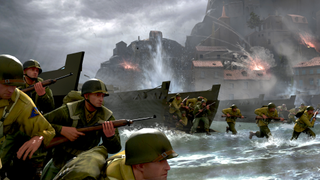
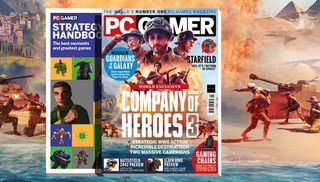
This article first appeared in PC Gamer magazine issue 360 in August 2021. Every month we run exclusive features exploring the world of PC gaming—from behind-the-scenes previews, to incredible community stories, to fascinating interviews, and more.
This Italian airbase has turned into Hell. The seared, metal carcass of a plane dominates one of the airstrips, surrounded by craters and puddles of blood. The hangars are now just skeletons, and next to them screaming men dance as they burn. There’s so much shouting, with soldiers yelling orders and warnings as they move between fleeting cover. Then, a rocket- propelled grenade, and the soldiers are gone. And through it all I have this inappropriately goofy grin on my face because, finally, I’m playing Company of Heroes 3.
The scene, my first fight in the campaign, is the Company of Heroes I remember, but with the intensity dialled way up. There’s more destruction and noise and chaos, and the busyness of the battlefield speaks to the long list of new tools and units that have been flung into the meat grinder.
Among the headline attractions jockeying for position is a large dynamic campaign in Italy, as well as a trip to North Africa that will be detailed later; the ability to control the ground, air, and naval forces of both the US and UK, in tandem; an entirely optional tactical pause system, just for singleplayer; and the promise of a huge pile of customisation that will be like catnip for loadout tinkerers. It has the immense scale of a Total War game, complemented by Relic’s experience with designing more bespoke, linear strategy games.
Team up
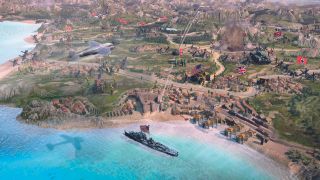
It’s the largest and most ambitious game Relic has put together, and it’s been in the works for a while. Along with a scale that evokes Total War, the team’s been inspired by another fellow Sega developer, Amplitude, borrowing its focus on the community. “They’re amazing at working with players,” says executive producer David Littman. “We’re taking the same technology that they use, Games2Gether, and we’ve been using that with a private community council. So we’ve had a 70-player council for over three years now. And they’ve been playing the game for three years.” These players are one of the reasons why Company of Heroes 3 is set in Italy and North Africa – it was initially going to be in the Pacific theatre – so Relic’s been getting feedback from the people who play Company of Heroes the most right from the beginning.
In this early build, the campaign begins in medias res, following the arrival of US and UK forces in Italy. There’s already been some fighting, and I’m given one of three different approaches to select, determining what forces I get to control at the start. I have to begin in Naples, but eventually there will be other choices for starting locations. I want all the toys, naturally, so I go for the option that lets me command a mix of US and UK forces. I’ve got one big goal: take the indomitable Monte Cassino, opening up a way to Rome. First, though, lots of dramatic battles.
The largest and most ambitious game Relic has put together.
While Relic has dabbled in dynamic campaigns before, it played second fiddle to the RTS action – not so in Company of Heroes 3. Both layers share the spotlight and are fundamentally interconnected. What you can do in the RTS layer can be replicated in the turn-based campaign, whether it’s bombarding the enemy with artillery strikes or plonking down some sneaky mines to scupper troop movement.
This ‘holistic loop’ is one of the main pillars of Company of Heroes 3 and makes this undeniably complex game feel significantly more intuitive. There’s a level of consistency and permanence that even Total War hasn’t achieved, and while Littman apologetically explains that the connection between the campaign and missions “simply isn’t there yet”, I think he’s being humble. Sure, there are still gaps, and some features not working quite like I expected, but broadly this is already a game where the relationships between the systems are very strong and very apparent.
The biggest gaming news, reviews and hardware deals
Keep up to date with the most important stories and the best deals, as picked by the PC Gamer team.
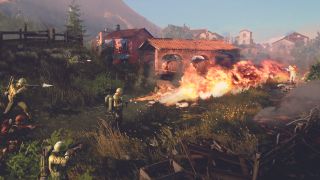
Tourist Trap
My army is hanging around Naples, with the sprawling Italian countryside stretched out before them. It’s a chunky map, but only a small slice of the full Italian campaign that we’ll get to play at launch. Each discrete bit of territory offers something, whether it’s more resources, another link in the supply chain, or access to air and naval forces. You don’t need to take every town in Italy, but I quickly found myself being seduced by the promise of total conquest and all the goodies that come with it.
It’s a fetching map, too, with lots of little cosmetic flourishes, like Vesuvius standing next to Pompeii, huge and menacing, or the striking Monte Cassino, which looks lovely even when it’s surrounded by barricades, tanks, and AA guns. But Relic’s also built it with an eye towards logistics and authenticity.
“It’s got that Mediterranean palette, but we’re also spending a lot of time looking at the construction of each of the territories,” says lead campaign designer Andrew Deneault. “We’ve looked at old World War II maps of rail assessments done by the Royal Engineers. So where were the rail lines? Where were the roads? Which roads were functional? As we’re building the map, we’re taking note of which highways the Allies used that were serviceable for tanks and things like that, which ones had hard surfaces and which ones were dirt tracks. So there’s a lot of thought, a lot of love, a lot of attention being given to the map, I think mechanically as well as from the presentation layer.”
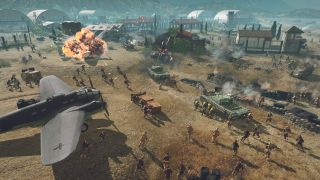
Flight Delayed
After spending a bit of time admiring Italy, I get back to the war. My first target is the nearest airbase, giving me access to handy things like aerial reconnaissance and paratrooper drops, which will come in handy in both the campaign map and missions. Before storming the airbase, however, I have to decide my approach.
I’ve got several companies and detachments at my disposal, and how I combine them will have a big impact on the battle ahead. Companies are your primary units that you’ll use to engage the enemy in real-time battles, running the gamut from American airborne units to devastating Indian artillery. Across the war, they get points that can be spent on a variety of upgrades and specialisation options. They’re backed up by detachments, which can still march across the map on their own, taking territory and getting into turn-based fights. They can’t actually instigate real-time battles on their own, however, but if they are near or attached to a company when one starts, they can provide a range of benefits.
Being a cautious commander, I decide to bring a medical detachment with me. On the campaign map, this detachment has a healing ability, and in missions this translates to a very helpful little truck that passively heals any troops standing near it. The truck can be destroyed, of course, and I turn protecting it into a personal side mission. Battles also conjure up explicit optional objectives, like finding intel or finding and taking out a specific enemy.
The medical truck proves to be a significant boon, given that it’s been a while since I played Company of Heroes. As handy as it is, though, it pales in comparison to the tactical pause feature. My reflexes ain’t what they used to be, so the ability to pause the action at any time to issue and queue commands is a genuine lifesaver, especially when I split my forces up and find myself managing multiple fights.
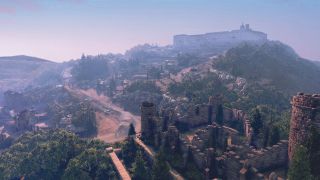
Everyone Freeze
It was introduced to make Company of Heroes 3 more accessible to players of all skill levels without removing the complexity and frenetic fights the series is known for, but I think even experienced RTS players will find it useful. “Something I like about the tactical pause is that it’s a different kind of payoff, queuing up a number of orders and then seeing them fulfilled,” says Deneault. “Taking a piece of territory, using a grenade, pinning the target, flanking, breaching a structure – you can set up some of those more advanced inputs, and in a way that, after you unpause, you can watch it unfold and see if it works. And if it does, there’s a great payoff there.”
Companies are your primary units that you'll use to engage the enemy in real-time battles.
My first Company of Heroes 3 mission is a thrill – a dramatic battle lit up by countless fires and explosions, courtesy of the airbase’s many fuel-filled barrels. At one point, I have to charge across a mostly empty runway, using the occasional ditch to hide my troops, and when one isn’t available, my poor medical truck. In the north, by the hangars, other soldiers duke it out with entrenched Nazis, as buildings are blown to smithereens. They get pinned down by a sniper in a tower, but smoke grenades and rockets make short work of it. Amid the fracas, I’m plonking down new buildings near my HQ, recruiting units and upgrading my existing ones as they rank up. When my engineers get flamethrowers, that’s when we really start cooking. There’s so much going on that I forget all about the intel, but I still manage to take the airbase, giving me another tool to make my march north, to Monte Cassino, just a little bit easier.
The level of destruction has always been one of Company of Heroes’ most memorable traits, so naturally Relic has given the system a lot of attention. Art director Tristan Brett and his team have worked tirelessly to create gorgeous Italian towns and villages, all so they can be mercilessly destroyed. The destruction system starts with construction, he tells me. “So we build all the internal framework of the houses, the tiles and everything are really built, so they act like the proper material and slide off the framework. So a lot of thought went into how we build the structures, before we talk about how to break them.” I’ll admit I do feel a little bit guilty after destroying them all. But it’s just so satisfying.
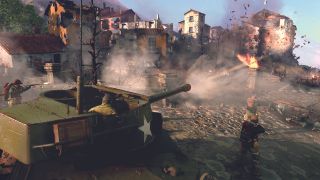
Falling Apart
Every projectile feels tangible and deadly when it’s pounding walls to dust, and there’s a grim beauty to all the devastation. Sometimes it feels like you’re building a warzone rather than destroying a town. And objects don’t just have two states – they aren’t simply standing or destroyed. The system is gradual and modular, telling the story of how things were blown up, whether it’s a building, a tank, or a lovely garden. There have also been practical improvements, so fallen masonry can now be used as cover, and if troops are underneath when it’s falling they might get crushed. If the thought of all these demolished buildings is making you feel sad, you can mitigate some of the destruction by using the new breach system to get enemies out of buildings instead of levelling them. Breaching troops will toss in a grenade and rush the enemy, or better yet, fill the interior with fire from a flamethrower. Enemies will try to flee, but that’s why you stick some guys out back.
Emboldened by my first victory, I step into my second fight, a random skirmish, with a confident swagger. My arse gets thoroughly kicked. If this had been Company of Heroes 1 or 2, that would have been it for me, but in this World War II sandbox I have to live with my failure. Battle outcomes aren’t black and white, either. While my company takes some damage, it survives, and the enemy gains no ground. In fact, it’s actually taken more damage. It might have won the skirmish, but it was a Pyrrhic victory. It’s also possible to completely destroy an enemy company or detachment before the battle begins. Units can exchange fire once-per-turn on the campaign map, and artillery strikes from your companies or naval support can make fast work of them, saving time and the lives of your troops.
Notably, that naval support isn’t off-screen. So not only will you be able to hammer the enemy before you engage in a skirmish, you’ll also be able to directly control your ships on the campaign map, moving them into a better position, or even depositing troops behind enemy lines. In this build, it’s a doddle, but Relic’s planning some coastal threats as well, making a journey by sea a bit riskier for the navy.
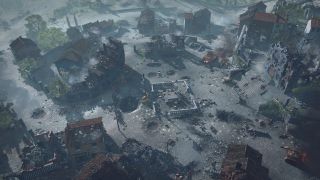
Hide and Seek
Plenty more skirmishes will accompany the bespoke missions at launch. As an unrepentant turtler, I’m especially happy to hear that proper defensive missions will be in the mix, giving you time to set up your fortifications and lay traps.
Lead mission designer Sacha Narine tells me that he wants to give the defensive skirmishes more of a handmade feel, referencing the excellent Carentan Counterattack mission from the first Company of Heroes, which gave you ten minutes to build up your defences before the hordes of Germans arrived. And then there are the more unusual modes, like skirmishes where you need to rout and then chase the enemy so nobody can escape.
Enemy Commanders have personalities that inform their tactics.
As I get to work liberating Italy, some chums chime in. I’ve got a trio of advisors, representing the British, US, and Italian partisan forces. These characters give the war a face, along with another path to unlock more upgrades and abilities, ethical conundrums, and some internal tension. The most interesting among them might be the partisan advisor, who reflects the civilian contributions to the war, and their toll. When my American bud tells me to bomb Monte Cassino, to make our assault easier, his partisan counterpart warns that there might be civilians hiding in the area we’re targeting, advising me to send in partisans first to make sure. Some choices aren’t either/or deals, so picking one suggestion doesn’t necessarily mean you can’t then pick the others, but sometimes you’re going to have to ignore someone’s advice, which they won’t like.
“One of the big themes of the narrative is the rivalry between America and the UK,” says lead narrative designer Báirbre Bent. But while you might pick favourites, over the course of the war you can still try to please everyone. “In fact, that’s possibly the best way,” she adds. And you’ll get to know them, too. “One thing we’re looking into is a way that you can get a deeper understanding of why these sub commanders want you to do what they’ve asked you. And we’re hoping to bring that in – that there’ll be a way for the player to opt in to get a bit more depth and understanding behind each sub commander’s vision for the war.”
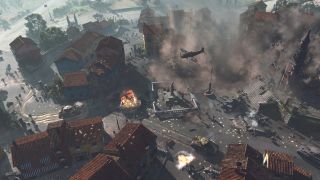
Know your Enemy
The Germans aren’t faceless adversaries, either. Enemy commanders have personalities that inform their tactics, and may react differently depending on the situation – a commander on the edge of obliteration with seemingly nothing to lose might become ultra aggressive and make you fight harder for every kill. These aren’t things you’ll necessarily know straight away, but if you’re mates with the partisans, they’ll be able to dig up that kind of information.
While I’m painting the campaign map my colour, I get alerted to the presence of a special named opponent and nemesis of the partisans, Taube. This leads to a hunt for the deadly tank commander, which I’m able to speed up by finding key intel. Our first and final meeting takes place in a real-time tank brawl around a small town, culminating in what almost feels like a boss battle, his intimidating Tiger II heavy tank against my considerably more vulnerable troops. I take him out, but the town is dust.
Bent says the narrative team is still exploring ways to add more personality to all sides of the war, and it definitely pays off in the demo. The brutal battle with Taube is a highpoint in this slice of the campaign, and it’s that victory that finally makes me feel ready to march to the end, to Monte Cassino.
Every projectile feels tangible and deadly when it's pounding walls to dust.
End of the Line
Since I opted not to bomb Monte Cassino, the Germans are well- fortified and waiting for me, but at least they don’t have any backup from Taube and his tanks. It’s a large map, dominated by a huge hill and one big, winding road, which the enemy forces are obviously keeping a close eye on. Knowing they’ll be light on tanks, however, I strike with an armoured company, and it proves to be the right call. The journey up that mountain is slow and painful, and at the top I notice I have absolutely no infantry left. What I do have, however, is five Churchill tanks, and boy do we have some fun. The picturesque setting is turned into craters and rubble, quite a lot of it thanks to me, but I can’t feel sad. I’ve taken Monte Cassino.
Relic estimates that it should take around four hours to complete the slice I was fighting through. I played for 11. There were some known bugs and performance issues slowing me down towards the end, but I really spent so long in Italy because I didn’t want to finish the war. I’ve been wandering this RTS desert for years, but now there’s this oasis, and for a day I got to submerge myself in it. Even in this early state, Company of Heroes 3 is very impressive, and I just hope it isn’t some sort of mirage. And you can check it out for yourself. While it won’t be launching until 2022, a pre-alpha demo is already available via the Games2Gether programme. You’ll be able to blow up tanks and breach buildings with flamethrowers until August 3.

Fraser is the UK online editor and has actually met The Internet in person. With over a decade of experience, he's been around the block a few times, serving as a freelancer, news editor and prolific reviewer. Strategy games have been a 30-year-long obsession, from tiny RTSs to sprawling political sims, and he never turns down the chance to rave about Total War or Crusader Kings. He's also been known to set up shop in the latest MMO and likes to wind down with an endlessly deep, systemic RPG. These days, when he's not editing, he can usually be found writing features that are 1,000 words too long or talking about his dog.
Most Popular

